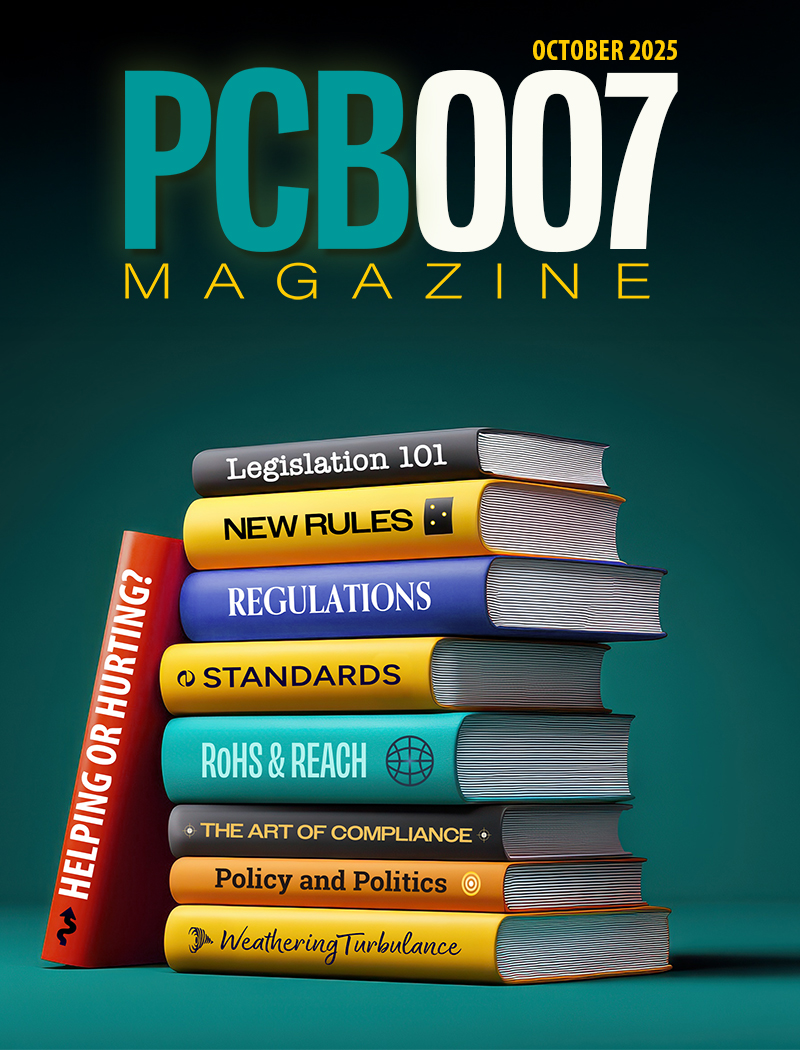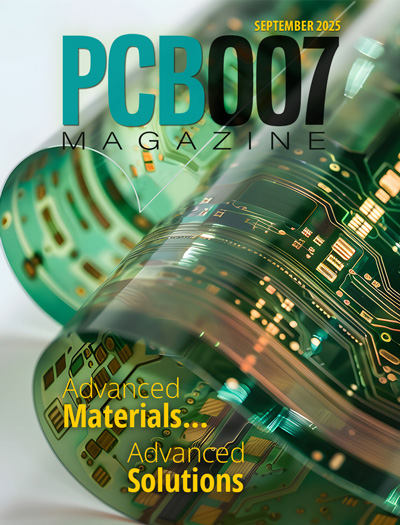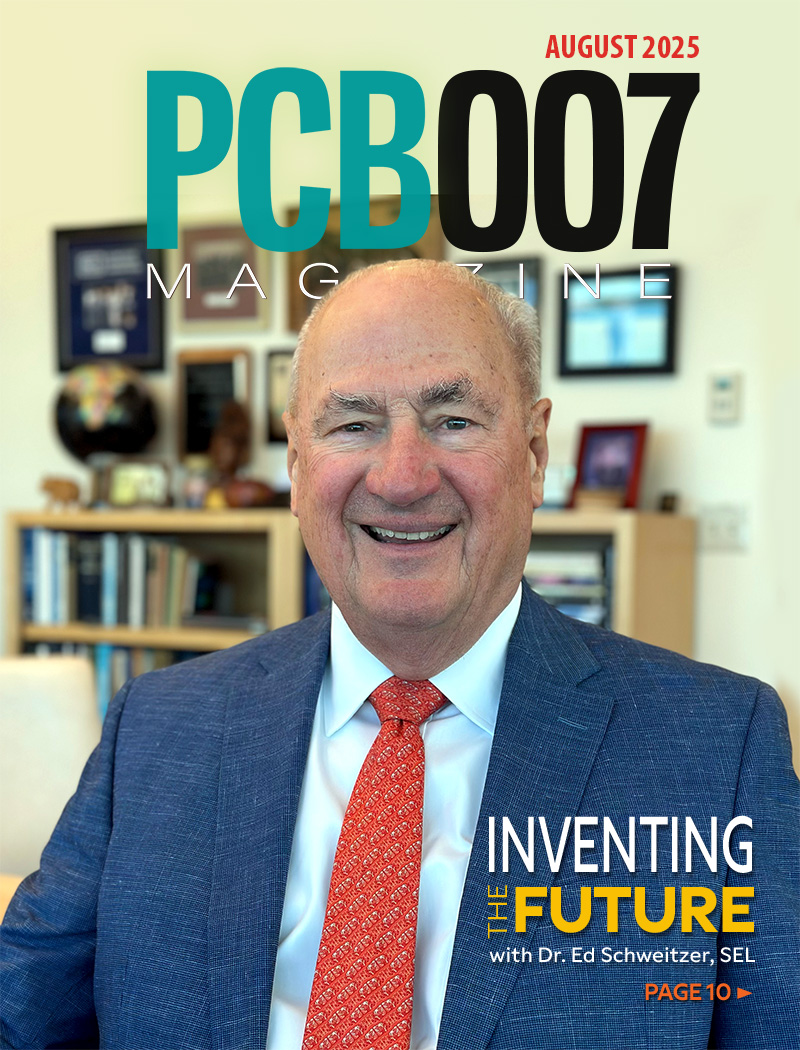-

- News
- Books
Featured Books
- pcb007 Magazine
Latest Issues
Current Issue
The Legislative Outlook: Helping or Hurting?
This month, we examine the rules and laws shaping the current global business landscape and how these factors may open some doors but may also complicate business operations, making profitability more challenging.

Advancing the Advanced Materials Discussion
Moore’s Law is no more, and the advanced material solutions to grapple with this reality are surprising, stunning, and perhaps a bit daunting. Buckle up for a dive into advanced materials and a glimpse into the next chapters of electronics manufacturing.

Inventing the Future With SEL
Two years after launching its state-of-the-art PCB facility, SEL shares lessons in vision, execution, and innovation, plus insights from industry icons and technology leaders shaping the future of PCB fabrication.
- Articles
- Columns
- Links
- Media kit
||| MENU - pcb007 Magazine
Innovative Circuits Relies on SCHMID’s InfinityLine
August 28, 2018 | Innovative CircuitsEstimated reading time: 1 minute
To increase its production capacity Innovative Circuits has ordered a new alkaline etching line with tin stripper as well as a resist-stripper machine from the equipment manufacturer SCHMID. With the acquisition of the new production equipment the American bare-board PCB supplier is strengthening its technological advance and secures a long-term planning security.
Both systems will be manufactured in SCHMID’s optimized InfinityLine design, which is the combination and innovative optimization of previous SCHMID CombiLine and PremiumLine. The InfinityLine adopts for instance the small passage slots from CombiLine or the spray manifold connection from PremiumLine and combined the advantages of both modular systems.
The SCHMID alkaline etching line permits a much higher accuracy over the etched surface and therefore an optimized geometry of the etching foot. The Fineline spray system and the intermittent etching with single nozzle control enable an etching process with qualities that were considered hard to achieve until recently.
“The new SCHMID equipment enables uniform etching pattern and line/space structures in circuit boards with an etching factor capability superior to previous offerings,” says Dale Lovell, Chief Engineer at Innovative Circuits.
Moreover, the alkaline InfinityLine etching module considerably reduces the scrap rate and the amount of reworking in the etching technology sector. Depending on the production lot, the system automatically adjusts the parameters required for processing and closely maintains the correct chemical parameters. Product-specific recipes can be stored and hence set-up times reduced.
“We have made technological improvements with regard to chemical carryover, filtration and dosing accuracy. The machine availability has been further increased and the very compact and user-friendly design makes our equipments easily accessible for maintenance,” says Fred Johnson, Director Sales North America, Business Unit Electronics at SCHMID. Above all, the reproducibility of the etching which results from the recipes stored in the system gives Innovative Circuits a distinctive competitive advantage.
Innovative Circuits
Innovative Circuits, based out of metro Atlanta, is a fabricator of high reliability printed circuit boards. Since 1998 Innovative has supported defense, aerospace and commercial applications with solutions that meet the most demanding challenges. Innovative Circuits is ITAR registered and ISO 9001:2015 certified for fabrication of complex rigid, teflon, flex, and rigid-flex circuitry. For additional information please click here.
Testimonial
"In a year when every marketing dollar mattered, I chose to keep I-Connect007 in our 2025 plan. Their commitment to high-quality, insightful content aligns with Koh Young’s values and helps readers navigate a changing industry. "
Brent Fischthal - Koh YoungSuggested Items
Episode 6 of Ultra HDI Podcast Series Explores Copper-filled Microvias in Advanced PCB Design and Fabrication
10/15/2025 | I-Connect007I-Connect007 has released Episode 6 of its acclaimed On the Line with... American Standard Circuits: Ultra High Density Interconnect (UHDI) podcast series. In this episode, “Copper Filling of Vias,” host Nolan Johnson once again welcomes John Johnson, Director of Quality and Advanced Technology at American Standard Circuits, for a deep dive into the pros and cons of copper plating microvias—from both the fabricator’s and designer’s perspectives.
Nolan’s Notes: Tariffs, Technologies, and Optimization
10/01/2025 | Nolan Johnson -- Column: Nolan's NotesLast month, SMT007 Magazine spotlighted India, and boy, did we pick a good time to do so. Tariff and trade news involving India was breaking like a storm surge. The U.S. tariffs shifted India from one of the most favorable trade agreements to the least favorable. Electronics continue to be exempt for the time being, but lest you think that we’re free and clear because we manufacture electronics, steel and aluminum are specifically called out at the 50% tariff levels.
MacDermid Alpha & Graphic PLC Lead UK’s First Horizontal Electroless Copper Installation
09/30/2025 | MacDermid Alpha & Graphic PLCMacDermid Alpha Electronics Solutions, a leading supplier of integrated materials and chemistries to the electronics industry, is proud to support Graphic PLC, a Somacis company, with the installation of the first horizontal electroless copper metallization process in the UK.
Electrodeposited Copper Foils Market to Grow by $11.7 Billion Over 2025-2032
09/18/2025 | Globe NewswireThe global electrodeposited copper foils market is poised for dynamic growth, driven by the rising adoption in advanced electronics and renewable energy storage solutions.
MacDermid Alpha Showcases Advanced Interconnect Solutions at PCIM Asia 2025
09/18/2025 | MacDermid Alpha Electronics SolutionsMacDermid Alpha Electronic Solutions, a global leader in materials for power electronics and semiconductor assembly, will showcase its latest interconnect innovations in electronic interconnect materials at PCIM Asia 2025, held from September 24 to 26 at the Shanghai New International Expo Centre, Booth N5-E30


